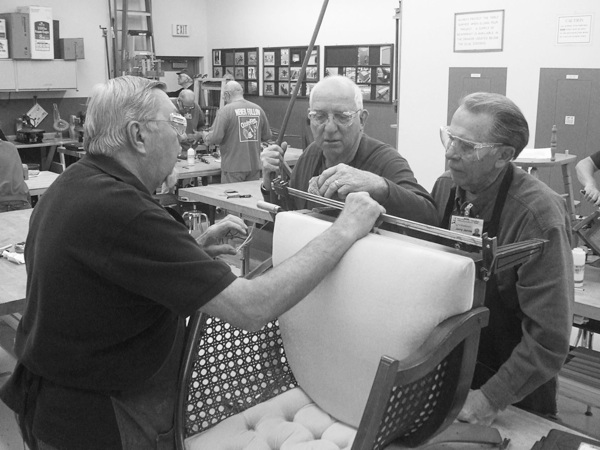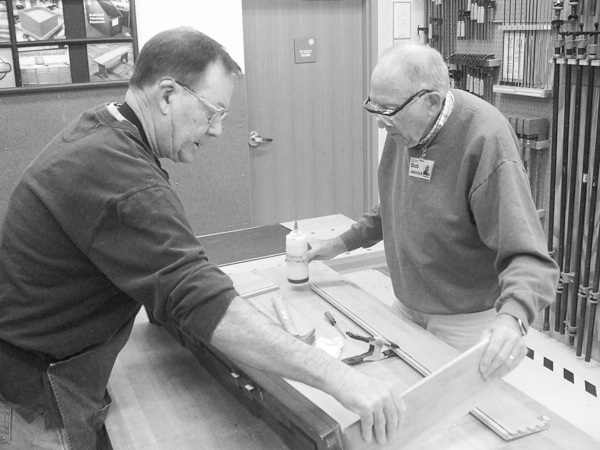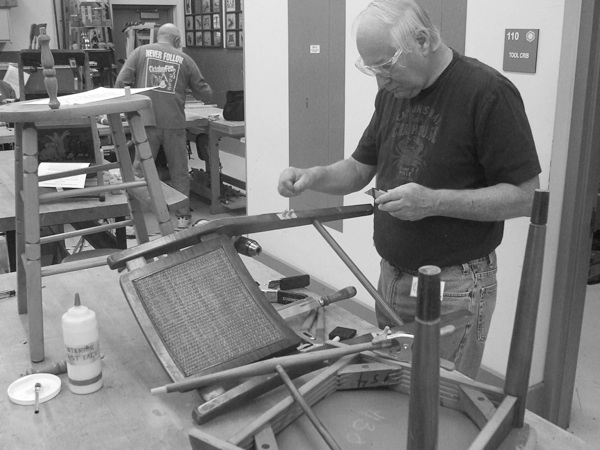On April 20, every workbench in the Millgrove Woodshop was covered with broken furniture and parts of furniture. Small teams of Woodchucks hovered around each bench, squinting at their projects and talking to the other team members, deciding on the best way to fix the problems.

Bill Lepola, Jim Barron, and Jerry Jarvis consult on the best way to repair a chair. (Photos provided)
Twenty-four residents brought their wobbly chairs, broken tables, and sticky dresser drawers to the Ask the Woodchucks repair day. We hold this event twice each year. As usual, most of the problems were wobbly and broken chairs. We are always amazed at the previous repairs that never seem to fix the problem, or maybe we only see the unsuccessful ones. An over-sized nail pounded through the leg into the end grain of the stretcher never works. Squirting glue all around the outside of a loose joint only makes the subsequent repair more difficult.
After some discussion about how to proceed, we usually remove the legs and stretchers from the chair. We then usually spend considerable time removing unsuccessful repairs and cleaning the tenons and the mortises. Occasionally, we have to make new stretchers. The next step is to dry fit the chair back together to make sure everything fits and that all four legs reach the ground.

Fred Teeman and Bob Janninck assemble a dresser drawer.
We are now ready to glue the chair back together. We use either yellow carpenter’s glue or in some cases Gorilla Glue. Clamps are then added to make sure the joints are fully engaged and they don’t move while the glue dries. We usually also clamp chairs and tables to the workbench, legs down, while the glue dries to make sure they don’t rock.
In past years, residents have brought in boxes filled with parts that we have to reassemble into a piece of furniture. We always ask what it is supposed to be so that we don’t assemble the pieces of a chest into a table.
One thing we can’t do in the shop is apply stain or finish to a piece of furniture. This applies not only to residents’ furniture brought to Ask the Woodchucks, but to furniture built in the shop by members. This is a rule we made nine years ago to prevent messy spills and to eliminate the danger of flammable oil-based finishes. When a repair disturbs the finish or when a new part has to be made, we explain to the resident how to stain and add finish to the affected area.
Now that spring is here, residents and landscaping companies are building some magnificent mulch volcanoes around the base of trees in the community. Unfortunately, these configurations are damaging the trees and, in some cases, killing them. Please go to the Sun Day website at www.mysundaynews.com and reread the column on mulch volcanoes. It was published on November 4, 2010.
If you have a gas or charcoal grill on your deck or patio, be sure to keep it away from your siding. The heat is enough to melt the vinyl siding on your house, as more than a few of your neighbors can attest.
If you have suggestions for future tips or have questions about maintenance around your home, submit them to ask.the.woodchucks@gmail.com.





